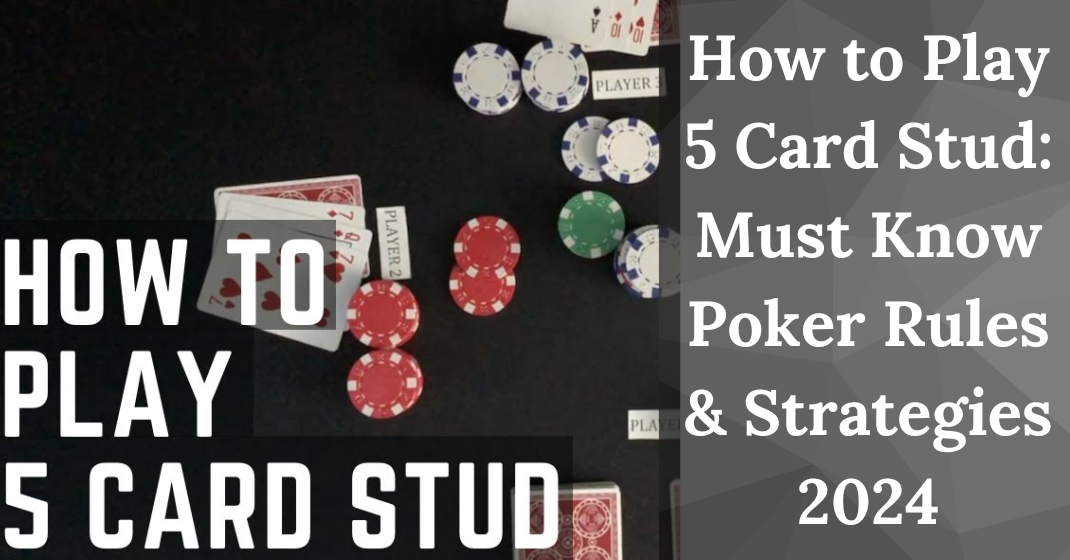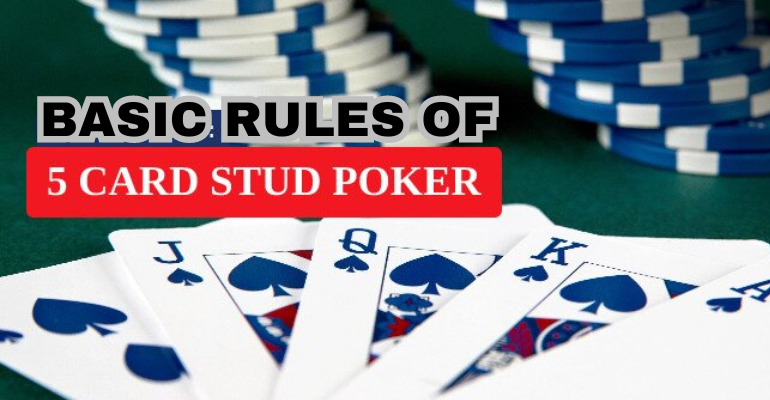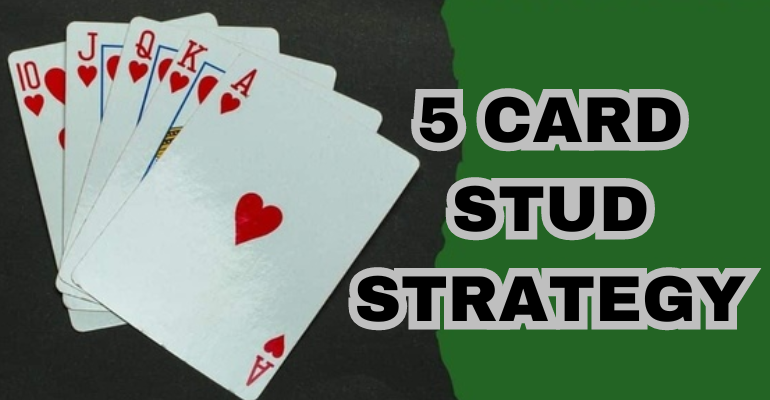How to Play 5 Card Stud: Must-Know Rules & Strategies 2024

Five Card Stud is one of America’s first and most iconic poker games, emerging during the American Civil War. It’s the game that started the Stud genre of Poker, rising in popularity in the Antebellum period of the United States.
The game became widespread on both sides during the war, and its popularity kept evolving. In this comprehensive guide, you’ll learn the basic rules of 5 Card Stud, the betting structure and limits, and the 5 Card strategy. So, let’s get started!
BASIC RULES OF 5 CARD STUD

To start with 5 Card Stud, you’ll need at least two players seated at the table. Before the cards are dealt, each player must put in an ante, a small bet everyone contributes to the pot. The table stakes typically determine the size of the ante and can be as low as 10 per cent of the smaller bet. For example, in a $5/$10 game, the ante could be $0.50.
Once the antes are placed, the dealer starts distributing the cards, beginning with the player to their left. Each player receives two cards – one face-down (known as the “hole” card) and one face-up (known as the “door” card).
Also Read: How To Bet In Blackjack (Must-Know Strategies For Beginners)
BETTING STRUCTURE AND LIMITS

5 Card Stud is usually played as a limit game. That means that the amount you can bet and raise is pre-established.
For example, if you’re playing a 5 Card Stud game with $5/$10 limits:
- The standard bet is $5.
- The antes are usually much smaller and can be determined by the players. They can be as low as 10 percent of the smaller bet, which in this case would be $0.50.
- The bring-in is more significant than the ante but smaller than the small bet, which in this case could be $2.
Betting in 5 Card Stud occurs in what we call ‘streets’. We number the streets based on the number of visible cards.
- The first player can check the bring-in or raise to the small bet, which is $5.
- If the player calls, the following player can fold, call the bring-in or raise to the small bet amount of $5. If the bet becomes $5, the other player can raise $5. Usually, games have a limit of three raises at this stage.
There are also Pot-Limit and No-Limit variations of 5 Card Stud. It all depends on the site, casino or home game you play at.
5 CARD STUD STRATEGY

While 5 Card Stud is a relatively straightforward poker game, there are several strategies we can employ to increase our chances of success.
Starting Hand Selection
One of the most critical aspects of the 5 Card Stud strategy is selecting the right starting hands to play. Generally, we should look for high-value door cards, such as:
- High pairs (Aces, Kings, Queens)
- High-card combinations (Ace-King, King-Queen)
- Medium pairs (Jacks, Tens, Nines)
For example, if we’re dealt A♠ (spades) face-up and K♥ (hearts) face-down, we have a strong starting hand and should consider raising when it’s our turn to act.
Position and Decision-Making
Our position at the table can significantly impact our decision-making process. Being in a later position allows us to observe our opponents’ actions before moving.
For instance, if we have a pair of Queens (Q♣ face-up and Q♦ face-down) and the player before us with a King showing bets, we may want to raise to build the pot and protect our hand.
Bluffing Considerations
While bluffing opportunities are limited in 5 Card Stud, there are still some situations where a well-timed bluff can be effective. One common strategy is to steal the antes when we have a high-value door card, such as an Ace or King.
Another bluffing opportunity arises when we have a hidden pair. For example, if we have 7♥ face-up and 7♣ face-down, we can represent a more substantial hand by betting or raising, especially if our opponents’ door cards are lower in value. However, it’s essential to be cautious when attempting to bluff in 5 Card Stud.
Evaluating Opponents’ Hands and Draws
As most of our opponents’ cards are exposed, it is crucial to pay attention to their potential hands and draws. By observing their door cards and the community cards, we can estimate the likelihood of them having a solid hand or drawing to a better one.
For instance, if an opponent shows two suited cards, there’s a higher probability they’ll draw to a flush. In this case, we should be more cautious about betting or raising with a weaker hand.
Also Read: How To Play 3 Card Poker: Must Know Tips And Strategies!
Adjusting to Game Variations
5 Card Stud can be played in various formats, such as high, low, or high-low splits. Adapting our strategy to the specific game variation is essential for success. In a high-low game, we should aim for hands that can win both the high and the low portions of the pot, such as a wheel (A-2-3-4-5) or a solid high hand with a low draw. In a lowball game, we aim to have the lowest possible hand, so we should avoid playing high cards and focus on drawing to the best low hand possible.
By mastering these 5 Card Stud strategies and continually adjusting our play based on our opponents’ actions and the game format, we’ll be well on our way to becoming skilled players. Remember to stay observant, be cautious with our bluffs, and always consider the strength of our starting hand and our position at the table.
CONCLUSION
In conclusion, 5 Card Stud has simple basic rules and a rich history. By understanding the betting structure, various strategies, and hand rankings given in this article, one can confidently dive into this classic poker variant. So, embrace the nostalgia and timeless enticement of 5 Card Stud and relish the thrilling ride this iconic poker game has to offer. Need more guidance? Stay tuned with us!






